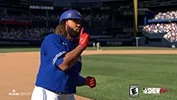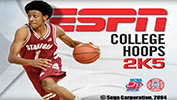|
Slider Theory 101
I posted this in another thread but thought it might get more traction in its own.
I think what sliders affect is one area that needs more detailed discussion. Too often you see posters explaining their sliders or gameplay in vague, general terms, or describing the effects of sliders that are just not correct. These sliders obviously change the values of some equation in the game's coding, and I think it would be useful to people tinkering with these things to understand what exactly is being affected when they change these values instead of going off of just "feel."
While I'm aware that some believe sliders behave differently between different modes, I do not believe they influence different aspects of the game in different modes. For instance, one might believe that the Pass Block slider set at 50 in practice mode or offline CCM plays more like 25 in online CCM or Play Now. But I do not believe that the Pass Block slider adjusts anything other than pass blocking in practice, play now, or any CCM mode.
Because of that, I think it's beneficial to experiment with sliders in Practice mode just to determine what the sliders do and do not affect since that mode has the most control. Playing in games can introduce other factors into the gamplay besides sliders (such as the players' consistency traits, hot/cold streaks, fatigue) that can influence results. Plus, you have the benefit of running the exact plays repeatedly to see what trends show up. Determining what precise values to set those sliders to, however, can be something left to whatever mode one believes the sliders play properly on.
With that in mind, here's some of the things I've found.
QB ACC: Really doesn't seem to show much differentiation until you go below 10. That's about the threshold for seeing errant throws. I haven't noticed any difference with throwing power or the cpu QB being more aware of open receivers.
Pass Blocking: Not entirely sure what this does. It seems to make the offensive linemen hold their ground more if turned high and get pushed around more if turned low. Didn't really see defensive linemen breaking off blocks with much differentiation between high and low settings though. And it doesn't seem to affect whether or not blitzers are picked up.
Catching: Haven't messed with it much. There does seem to be good variation in catches and drops when the slider is adjusted. Not sure if it can create suction catching animations or not.
RB Break Tackling: When set high, you will see the RB breaking more tackles through special moves like stiff arms and juking. This appears to be different than when a RB breaks a tackle due to the Tackling slider being low, which looks more like defenders arm tackling and not wrapping up. Not sure if this slider affects the tackle breaking of other offensive positions as well.
Run blocking: This seems to improve or worsen the movement that the offensive line gets on the defensive line. When set high, you see a surge from your offensive line and sometimes a pancake. When set low, you don't see any surge, and defensive linemen appear to have an easier time shedding the block when the RB gets close.
Fumbles: Like the catching slider, haven't experimented much, but there does seem to be differentiation with the ball popping out more or less when this slider is moved.
Pass Reaction Time: This slider is likely backwards. Turning the slider lower appears to improve the reaction time of defenders when a WR makes a cut. The easiest way to see this is to pick man coverage versus a comeback route. With the slider is set lower, the defender will stop and turn a split second after the WR makes his break on the route. When set higher, the defender takes longer to react to the cut and the WR has greater separation. This test can work with outs and hitches as well. Ins are odd in that much of the time, defenders will break on these routes very quickly as opposed to outs or comebacks. Not sure if this slider affects zone coverage, and if it does, not sure what to look for.
Interceptions: Like the Catching slider. Does seem to affect whether DBs will catch or drop INTs. Not sure if it affects how aggressive or passive they are when going for an INT.
Pass Rushing: Unlike the Pass Blocking slider, this one seems to affect whether defensive linemen will break off blocks through some sort of rip or swim. Its effect is most notable with DTs who tend to break off of blocks quicker when the slider is set high. The DEs are a different story though. There seems to be a glitch between the RT and LE where the LE is able to just push off the RT almost instantly and run around him for a sack. The RE is almost never able to do this. It doesn't seem to matter how good the RT is at pass blocking or how poor the LE is at pass rushing. Some plays just have the LE pushing off and around almost instantly. This does appear to be affected somewhat by the Pass Rush slider though, but it doesn't totally eliminate it even when turned down to 0.
*Edit: It appears the glitch is tied to the DE on the side the QB is facing, i.e., a right handed QB will see the LE glitching while a left handed QB will see the RE glitch. The glitch appears to be tied to certain offensive and defensive plays called in combination, but I'm not certain about this. When tested, certain plays like Nickel Cover 3 or Cover 2 would trigger the glitch when called against a particular offensive play but not another one. Very confusing.
Rush Defense Reaction Time: After further testing, it appears this slider controls when defenders will do an insta-shed of their block. When set high, DTs on inside running plays and LBs and DEs on outside plays would quickly shed their blocks as the RB got the ball. When set lower, defenders stayed blocked until the RB passed them. I believe this slider works best when paired with the Block Shedding slider.
Block Shedding: This looks like it controls how well defenders can beat blocks by ripping or spinning off them. It also might affect how often defensive linemen who are getting double teamed sink the blockers (pull the blockers down to the ground with them) or bust through a double team. Unlike Reaction Time, when defenders would shed their block with this slider set high, they would do it in a way that didn't take account of where the RB was. They would rip or spin off a blocker but not necessarily be in the hole or path of the RB. With Reaction Time set high, defenders would break their blocks in a way that put them closest to the RB. When set low, defenders would have a hard time breaking out of blocks. I believe the Block Shedding slider and Reaction Time should be adjusted in tandem as they appear to compliment each other.
Tackling: This slider controls how well defenders can tackle one on one. When set low, many more arm tackles and slipped tackles show up as opposed to the stiff arms and jukes you see from a high RB Break Tackle slider. Not sure if this has any affect on big hit tackles.
This what I've come up with by trying to isolate certain aspects of the game in practice mode. Since many of these sliders overlap (like Pass Blocking and Pass Rushing), I thought it would be beneficial to nail down what specifically these sliders do instead of taking the approach that a 25 Pass Block/75 Pass Rush = 50 Pass Block/50 Pass Rush. With all the thousands of man hours being put into tweaking these things, hopefully we can get some good insight.
Last edited by WilesThing; 09-20-2012 at 11:37 PM.
|











